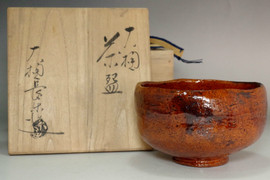Izumi Kisen (1926- ) Vintage Ohi pottery tea bowl #4304
- SKU:
- 4304
- Shipping:
- Free Shipping
- width: approx. 11.6cm (4 9⁄16in)
- height: approx. 8cm= (3 5⁄32in)
- weight: 277g (gross 523g)
Izumi Kisen (1926- )
Inherited his position at the Ohi ware Shoun kiln from the first-generation Kisen, and began producing pottery. Learned from his predecessor. Creates tea cups, mizusashi, vases, tea bowls, etc.
Ohi-ware
In Genbun 6 (1666) Tsunanori, the fifth of the Maeda line and daimyo of the Kaga Domain, wanted to promote tea culture and invited the 4th head of the Uransenke school of tea ceremony, Senso (Soshitsu Sen), to be the tea ceremony magistrate. At that time Senso was accompanied by a potter and tea bowl master, Chozaemon, who was the best student of the 4th head of the Raku line, Ichinyu.
Chozaemon was searching for the best potter's clay and upon discovering it in Ohi village in Ishikawa prefecture, he continued living and making pottery there in Kaga. He then took the surname Ohi from the village and it continues to be used to this day.
Ohi- ware is "Wakigama" (which is a general term for kilns used to make Raku-ware that are outside of the Raku line) of the Kyoto Raku line. Raku-ware has spread throughout Japan since the Meiji period, but in terms of makers who have directly inherited the Raku line techniques, Ohi-ware is said to be the only current Wakigama with such lineage.
Fine quality earth is coated with a red-yellow glaze, commonly known as Ohi Amber glaze, and fired at a low heat of 750-850 degrees. Ohi-ware is defined by the brilliant reddish-brown luster of the bowls' surface created by using the Amber glaze.


















